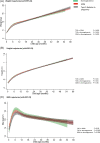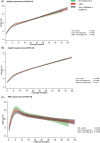Association between hyperglycaemia in pregnancy and growth of offspring in early childhood: The PANDORA study
- PMID: 35644889
- PMCID: PMC9539556
- DOI: 10.1111/ijpo.12932
Association between hyperglycaemia in pregnancy and growth of offspring in early childhood: The PANDORA study
Abstract
Background: Few studies have assessed whether children exposed to in utero hyperglycaemia experience different growth trajectories compared to unexposed children.
Objectives: To assess association of type 2 diabetes (T2D) and gestational diabetes mellitus (GDM) with early childhood weight, length/height and body mass index (BMI) trajectories, and with timing and magnitude of peak BMI in infancy.
Methods: PANDORA is a birth cohort recruited from an Australian hyperglycaemia in pregnancy register, and women with normoglycaemia recruited from the community. Offspring growth measures were obtained from health records over a median follow-up of 3.0 years (interquartile range 1.9-4.0). This analysis included children born to Aboriginal mothers with in utero normoglycaemia (n = 95), GDM (n = 228) or T2D (n = 131). Growth trajectories (weight, length/height and BMI) were estimated using linear mixed models with cubic spline functions of child age.
Results: After adjustment for maternal factors (age, BMI, parity, smoking, and socioeconomic measures) and child factors (age, gestational age at birth, and sex), children born to mothers with T2D or GDM had lower weight, length/height and BMI trajectories in infancy than children born to mothers with normoglycaemia, but similar weight and BMI by completion of follow-up. Children exposed to T2D had lower mean peak BMI 17.6 kg/m2 (95% confidence interval [CI] 17.3-18.0) than children exposed to normoglycaemia (18.6 kg/m2 [18.1-18.9]) (p = 0.001).
Conclusions: Maternal hyperglycaemia was associated with differences in early childhood growth trajectories after adjustment for maternal BMI. Exploration of associations between in utero hyperglycaemia exposure and growth trajectories into later childhood is required.
Keywords: Aboriginal; child; diabetes; growth; pregnancy.
© 2022 The Authors. Pediatric Obesity published by John Wiley & Sons Ltd on behalf of World Obesity Federation.
Conflict of interest statement
No conflict of interest was declared.
Figures



Similar articles
-
Breastfeeding and infant growth in offspring of mothers with hyperglycaemia in pregnancy: The pregnancy and neonatal diabetes outcomes in remote Australia study.Pediatr Obes. 2022 Jun;17(6):e12891. doi: 10.1111/ijpo.12891. Epub 2022 Feb 20. Pediatr Obes. 2022. PMID: 35187835
-
Association between maternal hyperglycemia in pregnancy and offspring anthropometry in early childhood: the pandora wave 1 study.Int J Obes (Lond). 2023 Nov;47(11):1120-1131. doi: 10.1038/s41366-023-01366-6. Epub 2023 Aug 22. Int J Obes (Lond). 2023. PMID: 37608089 Free PMC article.
-
Social and economic factors, maternal behaviours in pregnancy and neonatal adiposity in the PANDORA cohort.Diabetes Res Clin Pract. 2020 Mar;161:108028. doi: 10.1016/j.diabres.2020.108028. Epub 2020 Jan 19. Diabetes Res Clin Pract. 2020. PMID: 31962087
-
Gestational Diabetes Mellitus Is Associated with Age-Specific Alterations in Markers of Adiposity in Offspring: A Narrative Review.Int J Environ Res Public Health. 2020 May 4;17(9):3187. doi: 10.3390/ijerph17093187. Int J Environ Res Public Health. 2020. PMID: 32375312 Free PMC article. Review.
-
Offspring body size and metabolic profile - effects of lifestyle intervention in obese pregnant women.Dan Med J. 2014 Jul;61(7):B4893. Dan Med J. 2014. PMID: 25123127 Review.
Cited by
-
Insufficient sleep disrupts glucose metabolism during pregnancy by inhibiting PGC-1α.Ann Transl Med. 2022 Nov;10(22):1241. doi: 10.21037/atm-22-5551. Ann Transl Med. 2022. PMID: 36544637 Free PMC article.
-
Maternal diet and gestational diabetes mellitus modestly influence children's growth during their first 24 months.J Pediatr Gastroenterol Nutr. 2025 Aug;81(2):355-366. doi: 10.1002/jpn3.70098. Epub 2025 Jun 9. J Pediatr Gastroenterol Nutr. 2025. PMID: 40491247 Free PMC article.
-
Gestational diabetes mellitus and linear growth in early childhood.Front Endocrinol (Lausanne). 2024 Nov 27;15:1470678. doi: 10.3389/fendo.2024.1470678. eCollection 2024. Front Endocrinol (Lausanne). 2024. PMID: 39665025 Free PMC article.
-
Associations between maternal metabolic parameters during pregnancy and fetal and child growth trajectories from 20 weeks' gestation to 5 years of age: Secondary analysis from the ROLO longitudinal birth cohort study.Pediatr Obes. 2023 Jan;18(1):e12976. doi: 10.1111/ijpo.12976. Epub 2022 Sep 14. Pediatr Obes. 2023. PMID: 36102219 Free PMC article.
-
Clinical Characteristics of Offspring Born to Parents with Type 2 Diabetes Diagnosed in Youth: Observations from TODAY.Children (Basel). 2024 May 24;11(6):630. doi: 10.3390/children11060630. Children (Basel). 2024. PMID: 38929210 Free PMC article.
References
-
- WHO Multicentre Growth Reference Study Group . WHO Child Growth Standards: Methods and Development. World Health Organization; 2006.
-
- Baur LA, Garnett SP. Early childhood—a critical period for obesity prevention. Nat Rev Endocrinol. 2019;15(1):5‐6. - PubMed
-
- Geserick M, Vogel M, Gausche R, et al. Acceleration of BMI in early childhood and risk of sustained obesity. N Engl J Med. 2018;379(14):1303‐1312. - PubMed
Publication types
MeSH terms
LinkOut - more resources
Full Text Sources
Medical

